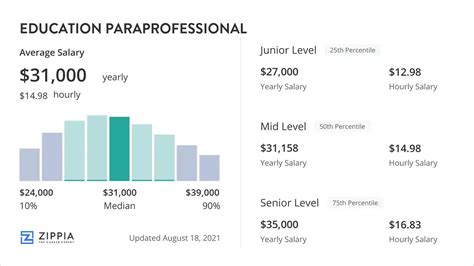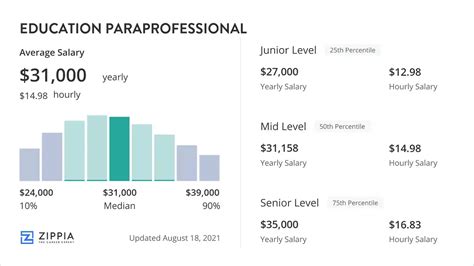For those drawn to the rewarding field of education, the role of an educational paraprofessional offers a direct path to making a tangible impact on students' lives. But passion for the job must be balanced with practical financial considerations. So, what can you realistically expect to earn?
While the role is known more for its intrinsic rewards than for high pay, a strategic approach can lead to a stable and fulfilling career. Nationally, an educational paraprofessional can expect to earn a median salary of approximately $31,000 to $34,000 per year, with a typical range falling between $27,000 for entry-level positions and over $40,000 for experienced professionals in high-paying districts.
This in-depth guide will break down the numbers, explore the key factors that influence your earning potential, and provide a clear picture of what to expect from a career as an educational paraprofessional.
What Does an Educational Paraprofessional Do?

Often referred to as a teacher's aide, paraeducator, or instructional assistant, an educational paraprofessional is a vital member of the instructional team. Working under the supervision of a licensed teacher, their primary role is to provide support to students and enhance the learning environment.
Key responsibilities often include:
- Working one-on-one or with small groups of students to reinforce lessons.
- Assisting with classroom management and supervising students in the cafeteria, on the playground, or on field trips.
- Helping teachers prepare instructional materials and set up classroom technology.
- Providing targeted support for students with special needs, including physical, emotional, or learning disabilities.
- Assisting students who are English language learners (ELLs).
Paraprofessionals are the essential support system that allows teachers to focus on delivering high-quality instruction to the entire class.
Average Educational Paraprofessional Salary

To understand the earning potential, it's best to look at data from several authoritative sources.
According to the U.S. Bureau of Labor Statistics (BLS), the median annual wage for teacher assistants (the BLS classification for paraprofessionals) was $31,010, or $14.91 per hour, as of May 2023. The BLS notes that the lowest 10 percent earned less than $24,110, and the highest 10 percent earned more than $47,150.
Reputable salary aggregators provide a similar outlook and offer a snapshot of the typical salary range:
- Salary.com reports a median U.S. salary for a Paraprofessional of $32,583, with a common range between $27,815 and $38,590.
- Payscale.com indicates an average hourly wage of around $15.85, with a range typically spanning from $12.50 to $21.00 per hour depending on experience and location.
- Glassdoor estimates a total pay of approximately $34,188 per year for paraprofessionals in the United States.
These figures confirm that while this is not a high-income profession, earnings can vary significantly. The following factors are the primary drivers behind that variation.
Key Factors That Influence Salary

Where you work, what you know, and who you work with all play a significant role in determining your final paycheck. Understanding these factors can help you maximize your earning potential.
### Level of Education
While a high school diploma is the minimum requirement in some districts, federal law often sets a higher bar. Under the Every Student Succeeds Act (ESSA), paraprofessionals working in Title I-funded schools must have:
- Completed at least two years of study at an institution of higher education; or
- Obtained an associate's (or higher) degree; or
- Passed a formal state or local academic assessment.
Meeting these requirements is essential for employment in many public schools. Furthermore, holding an associate's or bachelor's degree can place you on a higher pay scale within a school district's salary schedule, leading to a better starting salary and higher lifetime earnings.
### Years of Experience
Experience is highly valued in education. Most public school districts operate on a "step" salary schedule, where employees receive incremental pay raises for each year of service. A newly hired paraprofessional might start on "Step 1" of the pay scale, while a colleague with 10 years of experience could be on "Step 10," earning thousands of dollars more per year for performing the same duties. This system rewards loyalty and recognizes the practical skills gained over time.
### Geographic Location
Your salary as a paraprofessional is heavily influenced by where you live. States and metropolitan areas with a higher cost of living and strong teachers' unions tend to offer more competitive wages.
According to 2023 BLS data, the top-paying states for teacher assistants are:
1. Washington: $45,840 (Annual Mean Wage)
2. California: $44,560
3. Massachusetts: $43,730
4. Alaska: $43,010
5. District of Columbia: $42,670
Conversely, states in the South and parts of the Midwest tend to offer lower wages, which are often commensurate with a lower cost of living. It's crucial to research the specific salary schedules for school districts in your target area.
### School Type
The type of school you work for can impact your salary and benefits package.
- Public Schools: Generally offer the most structured and transparent pay, governed by district-wide salary schedules and union negotiations. Well-funded suburban districts often pay more than rural or underfunded urban districts.
- Private Schools: Salaries can vary dramatically. Elite, high-tuition private schools may offer competitive wages, while smaller or religiously affiliated schools may pay less than their public counterparts.
- Charter Schools: As publicly funded but independently operated schools, their pay scales are also variable and may or may not be tied to the local district's schedule.
### Area of Specialization
Developing specialized skills can make you a more valuable candidate and unlock opportunities for higher pay.
- Special Education: Paraprofessionals who work with students with significant needs (such as autism, severe developmental delays, or behavioral challenges) often receive a pay differential or stipend. These roles, such as a "Behavioral Aide" or a "1:1 Aide," require additional training and are in high demand.
- Bilingual Skills: In districts with large populations of English Language Learners (ELLs), bilingual paraprofessionals are critical. Fluency in a second language, particularly Spanish, can lead to a hiring preference and, in some districts, a pay supplement.
Job Outlook

The career outlook for educational paraprofessionals is stable. The BLS projects a 1% growth for teacher assistants from 2022 to 2032.
While this growth rate is slower than the average for all occupations, it is important to view it in context. The consistent demand is driven by rising student enrollment and a continued focus on inclusive education, which requires support for students with disabilities. Furthermore, job openings will consistently arise from the need to replace workers who transfer to other occupations or retire. This means that qualified and dedicated paraprofessionals will continue to be in demand across the country.
Conclusion

A career as an educational paraprofessional is a calling for those who want to foster student success from the front lines of the classroom. While the salary is modest, it provides a stable income and a direct way to contribute to your community.
For prospective professionals, the key takeaways are:
- Expect a Median Salary Around $31k-$34k: This is a realistic national average, but not a fixed ceiling.
- Your Choices Matter: You can significantly influence your earnings through strategic decisions. Pursuing higher education, gaining experience, and obtaining specialized skills are the most effective ways to advance on the salary schedule.
- Location is a Major Factor: Researching pay scales in different states and local school districts is essential for maximizing your income.
Ultimately, the role of an educational paraprofessional offers a unique blend of personal fulfillment and professional stability—a valuable combination for anyone passionate about the future of education.
